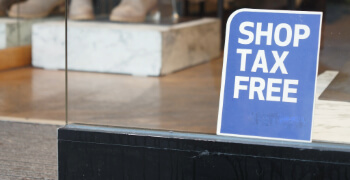
Utah to cut remote seller transaction threshold July 1, 2025
This blog post has been updated. It was originally published on January 22, 2025.
Utah is eliminating its economic nexus transaction threshold for remote sellers effective July 1, 2025. It’s in good company: Fourteen states have already ditched their remote seller transaction thresholds.
Currently, a business with no physical tie to Utah (aka a remote seller) must register for Utah sales and use tax if it sells tangible personal property, products transferred electronically, or services for storage, use, or consumption in the state, and either:
- Had more than $100,000 in gross revenue from those sales in the current or previous calendar year, or
- Made 200 or more separate transactions of those goods or services in the state in the current or previous calendar year
Senate Bill 47 repeals the 200-transactions threshold so that only the $100,000 sales threshold will remain. The legislation takes effect July 1, 2025.
This blog post will examine:
- What is a remote seller threshold?
- Do different states have different remote seller thresholds?
- Which states have eliminated their remote seller transaction thresholds?
- Why is Utah changing its economic nexus threshold?
Read on for answers to these questions or click on the link to jump to the section that interests you most.
What is a remote seller threshold?
A remote seller threshold is the level of sales activity in a jurisdiction that gives a remote seller economic nexus with that jurisdiction.
Economic nexus bases a tax obligation on a remote seller’s sales activity in a jurisdiction. Once a business has established economic nexus, it must obtain a sales tax permit and comply with all applicable sales and use tax laws.
Every state with a sales tax has an economic nexus sales tax law. Every economic nexus law provides an exception for businesses whose sales in the state are beneath a certain threshold — the economic nexus threshold or remote seller threshold.
Do different states have different remote seller thresholds?
Yes. Broadly speaking, there are six different categories of economic nexus thresholds:
- $100,000
- $100,000 or 200 transactions
- $100,000 and 200 transactions
- $250,000
- $500,000
- $500,000 and 100 transactions
That’s just the tip of the proverbial iceberg. Some economic nexus thresholds include exempt and/or resale sales while others only include taxable retail sales. Some include services; others don’t. State-specific remote seller threshold details can be found at our state-by-state guide to economic nexus laws.
Which states have eliminated their remote seller transaction thresholds?
Alaska, California, Colorado, Indiana, Iowa, Louisiana, Maine, Massachusetts, North Carolina, North Dakota, South Dakota, Washington, Wisconsin, and Wyoming have eliminated their transaction thresholds as of this writing.
The following jurisdictions currently have a threshold based on sales volume or number of transactions: Arkansas, Georgia, Hawaii, Illinois, Kentucky, Maryland, Michigan, Minnesota, Nebraska, Nevada, New Jersey, Ohio, Puerto Rico, Rhode Island, Utah, Vermont, Virginia, Washington, D.C., and West Virginia. Utah will be struck from this list on July 1, 2025, and added to the previous list.
Connecticut and New York use a sales and transaction threshold.
Why is Utah changing its economic nexus threshold?
Utah is a member of the Streamlined Sales and Use Tax Agreement (SSUTA, or SST), and the Streamlined Sales and Use Tax Governing Board is encouraging member states to get rid of their transaction thresholds.
“There’s a big initiative among the SST states to remove and update the transaction threshold,” says Chad Paulson, Manager of SST Government Affairs at Avalara. “It’s a burden for small sellers who do very low-dollar transactions to collect and remit in all these states.”
The 200-transactions threshold can also be costly for states to administer. For these two reasons, many sales tax experts support retiring it.
“The amount of tax collected should be greater than the cost of compliance,” observes Scott Peterson, VP of Government Relations at Avalara. “States have realized some businesses sell a lot of very inexpensive products, producing an amount of tax that is much less than the cost of compliance.” This is the incentive behind eliminating the transaction threshold.
Diane Yetter, President and Founder of the Sales Tax Institute and YETTER Tax, has described the $100,000 in sales or 200 transactions test as “the most onerous” economic nexus threshold used by states. “A third of our clients with sales under $50,000 in a state in the last year were required to register solely by exceeding the 200-transaction threshold,” she wrote in her testimony for a 2022 United States Senate Finance Committee hearing on the impact of the Wayfair decision on small businesses.
“The 200-transaction threshold is particularly problematic,” according to Manish Bhatt, a Senior Policy Analyst with the Center for State Tax Policy at the Tax Foundation. If you make 200 transactions for $5 each in Maryland, he explained during a webinar on post-Wayfair remote sales tax reforms, “for $1,000 of economic activity in Maryland you could be subject to collection and remittance obligations, and those compliance burdens may far exceed the amount that you’ve actually sold into the state.”
Check out our state-by-state guide to economic nexus laws to learn more about the remote seller thresholds in each state — there are a lot to them. And if you’re wondering whether your business is registered for sales tax in all the right states, our free economic nexus risk assessment can help.

Avalara Tax Changes 2026 is here
The 10th edition of our annual report engagingly breaks down key policies related to sales tax, tariffs, and VAT.
Stay up to date
Sign up for our free newsletter and stay up to date with the latest tax news.















